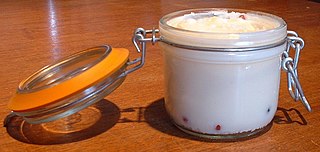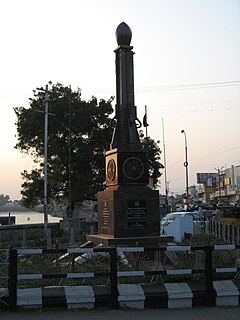
Mutiny is a revolt among a group of people to oppose, change, or overthrow an organization to which they were previously loyal. The term is commonly used for a rebellion among members of the military against an internal force, but it can also sometimes mean any type of rebellion against any force. Mutiny does not necessarily need to refer to a military force and can describe a political, economic, or power structure in which there is a change of power.

Tallow is a rendered form of beef or mutton fat, primarily made up of triglycerides.

The Indian Rebellion of 1857 was a major uprising in India in 1857–58 against the rule of the British East India Company, which functioned as a sovereign power on behalf of the British Crown. The rebellion began on 10 May 1857 in the form of a mutiny of sepoys of the Company's army in the garrison town of Meerut, 40 mi (64 km) northeast of Delhi. It then erupted into other mutinies and civilian rebellions chiefly in the upper Gangetic plain and central India, though incidents of revolt also occurred farther north and east. The rebellion posed a considerable threat to British power in that region, and was contained only with the rebels' defeat in Gwalior on 20 June 1858. On 1 November 1858, the British granted amnesty to all rebels not involved in murder, though they did not declare the hostilities to have formally ended until 8 July 1859. Its name is contested, and it is variously described as the Sepoy Mutiny, the Indian Mutiny, the Great Rebellion, the Revolt of 1857, the Indian Insurrection, and the First War of Independence.

Sepoy was originally the designation given to a professional Indian infantryman, usually armed with a musket, in the armies of the Mughal Empire.

Major-General The Hon. George Anson CB was a British military officer and Whig politician from the Anson family.

Mangal Pandey: The Rising is a 2005 Indian historical biographical drama film based on the life of Mangal Pandey, an Indian soldier known for helping to spark the Indian rebellion of 1857.

Mangal Pandey was an Indian soldier who played a key part in the events immediately preceding the outbreak of the Indian rebellion of 1857. He was a sepoy (infantryman) in the 34th Bengal Native Infantry (BNI) regiment of the British East India Company. In 1984, the Indian government issued a postage stamp to remember him. His life and actions have also been portrayed in several cinematic productions.

The Siege of Lucknow was the prolonged defence of the Residency within the city of Lucknow during the Indian Rebellion of 1857. After two successive relief attempts had reached the city, the defenders and civilians were evacuated from the Residency, which was then abandoned.

Begum Hazrat Mahal, also known as the Begum of Awadh, was the second wife of Nawab of Awadh Wajid Ali Shah, and the regent of Awadh in 1857–1858. She is known for the leading role she had in the rebellion against the British East India Company during the Indian Rebellion of 1857.

General Bakht Khan was commander-in-chief of the Indian independent forces in the region of Delhi during the Indian Rebellion of 1857 against the East India Company.

The Enfield Pattern 1853 rifle-musket was a .577 calibre Minié-type muzzle-loading rifled musket, used by the British Empire from 1853 to 1867; after which many were replaced in service by the cartridge-loaded Snider–Enfield rifle.
Historians have identified diverse political, economic, military, religious and social causes of the Revolt of 1857.
The Battle of Badli-ki-Serai was fought early in the Indian Rebellion of 1857, or First War of Indian Independence as it has since been termed in Indian histories of the events. A British and Gurkha force defeated a force of sepoys who had rebelled against the British East India Company. The British victory allowed them to besiege and ultimately capture Delhi.

A paper cartridge is one of various types of small arms ammunition used before the advent of the metallic cartridge. These cartridges consisted of a paper cylinder or cone containing the bullet, gunpowder, and in some cases, a primer or a lubricating and anti-fouling agent. Combustible cartridges are paper cartridges that use paper treated with oxidizers to allow them to burn completely upon ignition.
To "bite the bullet" is to “accept the inevitable impending hardship and endure the resulting pain with fortitude”. The phrase was first recorded by Rudyard Kipling in his 1891 novel The Light that Failed. It has been suggested that it is derived historically from the practice of having a patient clench a bullet in their teeth as a way to cope with the pain of a surgical procedure without anesthetic, though evidence for biting a bullet rather than a leather strap during surgery is sparse. It has been speculated to have evolved from the British expression "to bite the cartridge", which dates to the Indian Rebellion of 1857, but the phrase "chew a bullet", with a similar meaning, dates to at least 1796.
The Dum Dum Arsenal was a British military facility located near the town of Dum Dum in modern West Bengal, India.

The Vellore mutiny, or Vellore Revolution, occurred on 10 July 1806 and was the first instance of a large-scale and violent mutiny by Indian sepoys against the East India Company, predating the Indian Rebellion of 1857 by half a century. The revolt, which took place in the South Indian city of Vellore, lasted one full day, during which mutineers seized the Vellore Fort and killed or wounded 200 British troops. The mutiny was subdued by cavalry and artillery from Arcot. Total deaths amongst the mutineers were approximately 350; with summary executions of about 100 during the suppression of the outbreak, followed by the formal court-martial of smaller numbers.
During the Indian Rebellion of 1857 a column of troops led by the commander of the 24th Regiment of Foot was sent to disarm Bengal Native Infantry units believed to be at risk of mutiny in Rawalpindi and Jhelum. At Rawalpindi, the 58th Bengal Native Infantry were disarmed peacefully, however the two companies of the 14th Bengal Native Infantry resisted the attempt by force of arms. These two companies were quickly defeated by the British, loyal native troops and the local population. In Jhelum, also garrisoned by the 14th, the concurrently timed disarmament was much more violent. Thirty five British soldiers of the 24th Regiment of Foot were killed along with a number of Loyal Indian troops, by mutinous sepoys of the 14th Bengal Native Infantry. When the mutineers realised that they, with the exception of the Sikhs, were to be disarmed, they mutinied and made a vigorous defence against the force that had arrived from Rawalpindi to disarm them. The following night a significant number of mutineers managed slip away but most were subsequently arrested by the Kashmir authorities, into whose territory they had escaped.

The 3rd Bengal Light Cavalry, also known as the 3rd Bengal Native Cavalry, was a locally recruited regiment of the East India Company's Bengal Army. Raised in 1797, the regiment took part in conflicts throughout British India, serving with distinction in the Second Anglo-Maratha War, the First Anglo-Afghan War and the First Anglo-Sikh War, earning various battle honours.
Matadin Valmiki was an Indian freedom fighter who played a key part in the events immediately preceding the outbreak of the Indian rebellion of 1857. He was a Valmiki worker in a cartridge manufacturing unit of British East India Company. He was the first person who sowed seeds of the 1857 revolt.













